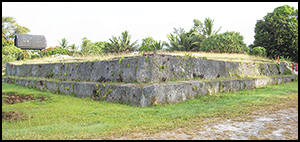Article contents
The rapid emergence of the archaic Tongan state: the royal tomb of Paepaeotelea
Published online by Cambridge University Press: 19 July 2016
Abstract

New research indicates that the royal tomb Paepaeotelea was built c. AD 1300–1400, more than 200 years earlier than its traditional association with Uluakimata I, who ruled when the Tongan polity was at its greatest extent. The large and stylistically complex tomb marks a dramatic increase in the scale of mortuary structures. It represents a substantial mobilisation of labour by this early archaic state, while the geochemical signatures of stone tools associated with the tomb indicate long-distance voyaging. The evidence suggests that the early Tongan state was a powerful and geographically expansive entity, able to rapidly organise and command the resources of the scattered archipelago.
- Type
- Research
- Information
- Copyright
- Copyright © Antiquity Publications Ltd, 2016
References
- 9
- Cited by




